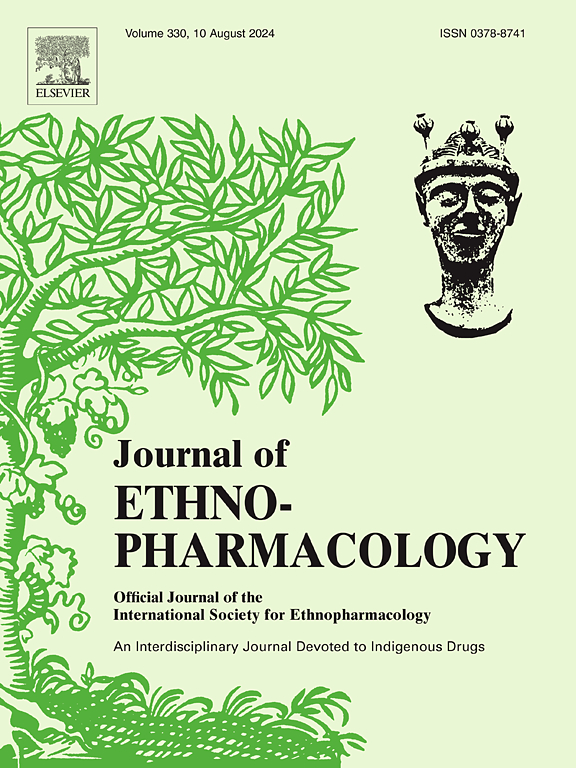Antiproliferative cassaine diterpenoid amines from the leaves and twigs of the traditional Thai medicinal plant Erythrophleum teysmannii (Kurz) Craib
IF 4.8
2区 医学
Q1 CHEMISTRY, MEDICINAL
引用次数: 0
Abstract
Ethnopharmacological relevance
Erythrophleum teysmannii (Kurz) Craib is a medicinal plant used by traditional healers in Laos and Thailand to treat cancer. Despite ethnopharmacological reports about plant extracts from this genus as cancer drug formulae, there is a knowledge gap about the chemical composition and potential pharmacological effects of E. teysmannii.
Aim of the study
The study aimed to investigate the phytochemical constituents of the leaf and twig DCM/MeOH extract of E. teysmannii and their antiproliferative properties, and to support its traditional uses.
Materials and methods
Bioassay-guided phytochemical investigation of the organic solvent extract of the plant led to the isolation of 21 pure compounds. Their structures were determined by extensive spectroscopic and spectrometric analyses, chemical derivatization and hydrolysis approaches, and ECD computational studies. Pure compounds were assessed for their antiproliferative activities against a panel of NCI-60 human tumor cell lines.
Results
Thirteen new cassaine diterpenoid amine monomers erythroteysamines A–M (1, 4–9, 11–14, 16, and 19) and two new dimers erythroteysamines N and O (20 and 21), together with six previously reported analogues (2, 3, 10, 15, 17, and 18) were isolated. Sixteen compounds were tested in the NCI-60 assay, and they all averaged low micromolar antiproliferative potency.
Conclusion
The isolated compounds from E. teysmannii showed antiproliferative activities, providing chemical and pharmacological evidence supporting the traditional use of the plant in herbal medicine.

从泰国传统药用植物红叶和细枝中提取的抗增殖cassaine二萜胺
民族药理学相关性红血球(Kurz) Craib是一种药用植物,被老挝和泰国的传统治疗师用来治疗癌症。尽管有民族药理学报道称该属植物提取物可作为抗癌药物配方,但对其化学成分和潜在药理作用的认识仍存在空白。目的:研究山参叶、枝DCM/MeOH提取物的化学成分及其抗增殖活性,为山参叶、枝DCM/MeOH提取物的传统药用价值提供依据。材料与方法以生物测定法为指导,对该植物的有机溶剂提取物进行了植物化学研究,分离得到21个纯化合物。通过广泛的光谱和光谱分析、化学衍生化和水解方法以及ECD计算研究确定了它们的结构。纯化合物对一组NCI-60人肿瘤细胞系的抗增殖活性进行了评估。结果分离到13个新的卡萨因二萜类胺单体A-M(1,4 - 9,11 - 14,16和19)和2个新的二聚体N和O(20和21),以及6个先前报道的类似物(2、3、10、15、17和18)。在NCI-60试验中,16种化合物均具有较低的微摩尔抗增殖能力。结论从地黄中分离得到的化合物具有一定的抗增殖活性,为地黄中药的传统应用提供了化学和药理依据。
本文章由计算机程序翻译,如有差异,请以英文原文为准。
求助全文
约1分钟内获得全文
求助全文
来源期刊

Journal of ethnopharmacology
医学-全科医学与补充医学
CiteScore
10.30
自引率
5.60%
发文量
967
审稿时长
77 days
期刊介绍:
The Journal of Ethnopharmacology is dedicated to the exchange of information and understandings about people''s use of plants, fungi, animals, microorganisms and minerals and their biological and pharmacological effects based on the principles established through international conventions. Early people confronted with illness and disease, discovered a wealth of useful therapeutic agents in the plant and animal kingdoms. The empirical knowledge of these medicinal substances and their toxic potential was passed on by oral tradition and sometimes recorded in herbals and other texts on materia medica. Many valuable drugs of today (e.g., atropine, ephedrine, tubocurarine, digoxin, reserpine) came into use through the study of indigenous remedies. Chemists continue to use plant-derived drugs (e.g., morphine, taxol, physostigmine, quinidine, emetine) as prototypes in their attempts to develop more effective and less toxic medicinals.
 求助内容:
求助内容: 应助结果提醒方式:
应助结果提醒方式:


